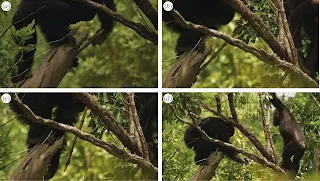 |
Blue Beach, N.S. The site is a trove of fossils from about 350 million years ago, when vertebrates first started emerging onto land. Credit: Jason Anderson |
It must seem to creationists that every few days their incredible shrinking little god is evicted from yet another gap and gets just a little bit smaller. It's almost the reverse of the Big Bang. I wonder if we'll hear a small 'pffut' when the little god finally disappears in it's own irrelevance.
A week or so ago, creationism's god was evicted from a gap which palaeontologists have dubbed
Romer's Gap. This is (or rather was) a gap in the fossil record of the early Carboniferous era where there should have been fossils of creatures intermediate between fish and terrestrial tetrapods. Now an analysis of fossil fragments found in just one deposit from that era revealed a rich diversity of intermediate fish-tetrapod fauna sitting there right in Romer's Gap.
Abstract
The lack of fossil tetrapod bearing deposits in the earliest Carboniferous (‘Romer’s Gap’) has provoked some recent discussions regarding the proximal cause, with three explanations being offered: environmental, taphonomic, and collection failure. One of the few, and earliest, windows into this time is the locality of Blue Beach exposed in the Tournaisian deposits at Horton Bluff lying along the Avon River near Hantsport, Nova Scotia, Canada. This locality has long been known but, because the fossils were deposited in high energy settings they are almost always disarticulated, so the fauna has not been described in detail. Recent intensive collection has revealed a diverse assemblage of material, including for the first time associated elements, which permits an evaluation of the faunal constituents at the locality. Although not diagnosable to a fine taxonomic level, sufficient apomorphies are present to identify representatives from numerous clades known from more complete specimens elsewhere. The evidence suggests a diverse fauna was present, including whatcheeriids and embolomeres. A single humerus previously had been attributed to a colosteid, but there is some uncertainty with this identification. Additional elements suggest the presence of taxa otherwise only known from the late Devonian. Depositional biases at the locality favor tetrapod fossils from larger individuals, but indirect evidence from trackways and tantalizing isolated bones evidences the presence of small taxa that remain to be discovered. The fossils from Blue Beach demonstrate that when windows into the fauna of ‘Romer’s Gap’ are found a rich diversity of tetrapods will be shown to be present, contra arguments that suggested this hiatus in the fossil record was due to extrinsic factors such as atmospheric oxygen levels. They also show that the early tetrapod fauna is not easily divisible into Devonian and Carboniferous faunas, suggesting that some tetrapods passed through the end Devonian extinction event unaffected.

|
Acanthostega.
The fragments found at Blue Beach were too small to be assigned to particular species. |
Not only were the many fragments undoubtedly those of limbed animals, having a limb skeletal plan similar to all tetrapods with a single femur and two lower limb bones but they were intermediate between finned fish and terrestrial tetrapods in having a variable number of fingers and toes. The basic tetrapod plan of five digits maximum had yet to evolve.
Romer's Gap, named after the U.S. paleontologist Al Romer who first wrote about it, was a period of about 15-30 million years following the end of the Devonian era characterised by primitive forests of giant tree ferns and a highly diversified fish fauna, and the appearance of forests with flowering plants, more modern aquatic fauna and a diversified terrestrial fauna. Several hypotheses had been put forward to explain it, including low oxygen levels which couldn't support terrestrial vertebrates, differences in geochemistry which didn't support fossilisation and a mass extinction at the end of the Devonian.
They were present much earlier than we gave them credit for. This gap itself isn't really a thing,it's just the result of a poor fossil record and the difficulty of finding rocks from this particular time. It also means that Romer's gap may be a misinterpretation of the fossil data.
Jason Anderson,
associate professor of veterinary anatomy,
University of Calgary, Alberta, Canada
There has been some geological support for the low oxygen theory and for a mass extinction at the end of the Devonian period, following which a low marine vertebrate diversity might have delayed the evolution of terrestrial vertebrates. However, this discovery suggests the gap may be more apparent than real and is merely due to lack of finds from the period. The authors point out that a rich diversity of terrestrial tetrapods early in the period points to an earlier evolutionary radiation.
Normally, creationism makes a great deal of these gaps in the fossil record and supposed missing transitional forms, claiming that Darwinian evolutionary theory requires all the intermediates and no gaps in the record, otherwise the entire theory disintegrates. This claim is, of course, nonsense, since the
TOE is not a theory about fossils but about how change occurs over time.
Nothing in the theory requires a comprehensive record and it only requires a little thought to realise that, with fossilisation being such an unusual and highly unlikely event for most species, the occurrence of a perfect series for every species is so hugely unlikely it could only be explained by design. In other words, a completely gapless fossil record would not be evidence for undirected, unintelligent natural evolution but for just the opposite. The lack of all these perfect series is actually evidence
against creationism and
for an entirely natural process.
But still, few creationists give much thought to things like that and like to believe that gaps like Romer's Gap somehow supports them, so it's always fun to watch them ignore it when science closes just such a gap, as it did with this find. It seems to be a difficult concept for creationists to grasp that science is essentially about discovery. If there were no gaps there would be nothing to discover. Significantly, of the myriad gaps closed by science, especially in the last few hundred years, not one single god has ever been found in any. Science only started to make real progress when it began to question whether there really was a god in every gap and went looking.











































